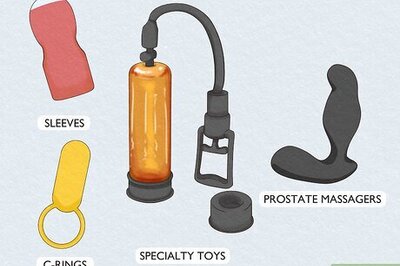
views
Healthcare, always a top concern for U.S. voters, has taken on even greater importance amid a coronavirus pandemic that has killed more than 205,000 Americans and cost millions more their jobs.
The death of liberal Supreme Court Justice Ruth Bader Ginsburg, meanwhile, has raised the stakes of the upcoming legal battle over Obamacare, formally known as the Affordable Care Act, when the high court hears the Trump administration’s effort to repeal the law days after the Nov. 3 election.
Here is a look at some of the vast differences on healthcare policy between Republican President Donald Trump and his Democratic challenger, former Vice President Joe Biden:
CORONAVIRUS
Trump has ceded much of the response to the pandemic to the states, rather than pursuing a national effort to expand testing, coordinate contact tracing and acquire protective equipment in bulk. He has also sent mixed messages on masks, which public health experts have said are crucial to slowing the spread of the virus.
Since the spring, Trump has pressed governors to reopen their states and has called on public schools to return to in-person instruction, arguing that the “cure cannot be worse than the disease.” He has often downplayed the deadliness of the virus and at times publicly undermined his administration’s own experts.
Trump signed into law several relief bills that have delivered trillions of dollars to individuals and businesses, though congressional Democrats have demanded more spending. The administration also launched “Operation Warp Speed,” an effort to support development of a coronavirus vaccine.
Biden has vowed to “listen to the science,” even saying he would consider another national economic shutdown if experts recommend it. He has called for a national mask standard, though he has acknowledged he may not have the authority to mandate their use.
His coronavirus plan calls for scaling up testing and contact tracing and promises to appoint a “supply commander” to oversee supply lines of critical equipment.
Biden has also proposed reopening insurance marketplaces for people who lost coverage through their jobs, expanding paid sick leave, and increasing pay for frontline workers. He has questioned whether Trump may try to politicize the vaccine process to boost his own re-election chances.
OBAMACARE
After years of failed attempts by Republican lawmakers to repeal the Affordable Care Act (ACA), Trump has turned to other tools to undermine the sweeping healthcare law: executive power and the courts.
The Justice Department is backing a lawsuit brought by several Republican-led states seeking to overturn the entire ACA, a case the U.S. Supreme Court is expected to hear on Nov. 10 – one week after Election Day.
Justice Ginsburg’s death has deepened concerns among Democrats that the court, which previously upheld the law 5-4 in 2012, might rule against the ACA. Under the law, more than 20 million Americans have gained insurance coverage.
The Trump administration has not proposed a comprehensive replacement, despite Trump’s vow to deliver a better, less-costly healthcare system. On Thursday, he signed two executive orders as part of what he called the “America First” healthcare plan, though they were seen as largely symbolic.
The Republican-backed 2017 tax overhaul bill eliminated the ACA’s individual mandate, which required most people to maintain insurance or face a penalty. Experts say the move increased premiums.
In addition, Trump has used executive power to boost short-term plans, which are exempt from the ACA’s requirement to cover basic benefits and guarantee coverage for people with pre-existing conditions.
The Trump administration also cut funding for staff and advertising intended to help people navigate the ACA marketplaces, where individuals can purchase private insurance, often with the help of government subsidies.
Biden has vowed to bolster the law, which was enacted during his first four-year term as Obama’s vice president. His own healthcare plan would cost $750 billion over 10 years and would be financed by raising taxes on the wealthy, according to his campaign.
Unlike some liberals, Biden does not support a single-payer system like Medicare for All.
Instead, Biden’s plan calls for a Medicare-like public option that would serve as an alternative, not a replacement, for private insurance.
In addition, several million people who are uninsured because they live in one of the 14 states that have refused to expand Medicaid – which provides coverage for low-income Americans – under the ACA would automatically be enrolled in the public option. He also has proposed expanding the subsidies available on the ACA marketplaces and capping cost increases.
PRE-EXISTING CONDITIONS
Trump has repeatedly said he will protect those with pre-existing conditions despite his administration’s effort to gut the ACA.
On Thursday, he signed an executive order intended to maintain insurance protections for people with pre-existing conditions if the Supreme Court overturns the ACA. But health experts immediately said the order had little practical import.
“The executive order has no specific policy to protect people with pre-existing conditions, nor does it even have a path to such a policy,” said Larry Levitt, a health policy expert at the nonprofit Kaiser Family Foundation. “This is more of a pinky promise than a plan.”
DRUG PRICES
Trump’s rhetoric has been more hawkish on prescription drug prices than that of most Republicans, but his results have been uneven.
He signed an executive order in early September aimed at setting Medicare prices for prescription drugs based on the cost in other countries, where prices are often lower. But experts say the order alone does not set policy; implementing the change will require a lengthy rulemaking process that would likely be challenged in court by drugmakers.
Both Biden and Trump support some form of importing prescription drugs from foreign countries to lower costs, though some experts have questioned whether doing so is feasible.
Trump also vowed on Thursday to deliver $200 cards to 33 million seniors to help pay for prescriptions, though it was not immediately clear where he would get the $6.6 billion without congressional approval.
Biden supports a bill approved by the Democratic-led House of Representatives last year that would allow Medicare to negotiate drug prices, as private insurers do.
Republicans, backed by the pharmaceutical industry, have argued it would force drugmakers to spend less on research and development, and the Trump administration has said it would veto the bill.
MEDICARE/MEDICAID EXPANSION
In April, Biden proposed lowering the Medicare eligibility age from 65 to 60, a move aimed at appealing to liberal voters. Such a change would potentially extend Medicare to some 20 million more Americans.
Trump has proposed several budgets that include cuts to Medicare and Medicaid spending. The Medicare reductions would not affect benefits but would instead change how providers are paid, according to Tricia Neuman, a Medicare expert at Kaiser.
The administration has supported imposing work requirements and other limitations on Medicaid eligibility, as well as installing caps on Medicaid spending growth and converting Medicaid to block grants – all moves that experts say would result in fewer people covered.
Disclaimer: This post has been auto-published from an agency feed without any modifications to the text and has not been reviewed by an editor



















Comments
0 comment